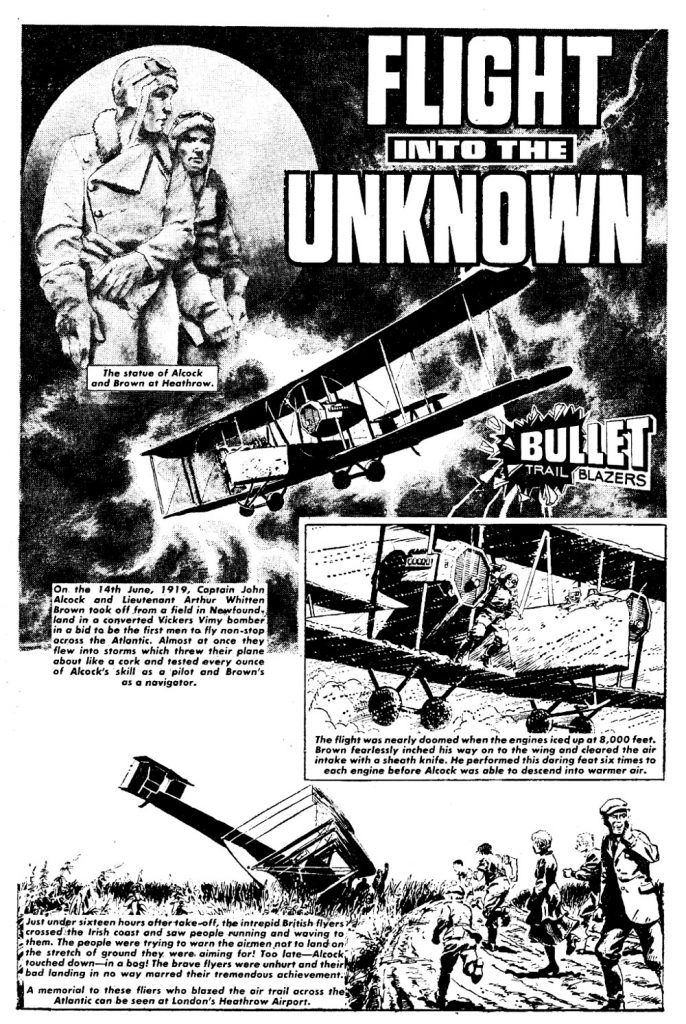
In the same week the first issue of Action hit the shelves, DC Thomson launched its rival publication, Bullet. Perhaps this was coincidence, perhaps someone in either company knew of the other’s plans, but such machinations are lost to history. What counts is the significance of each title within the market.
Battle was IPC’s answer to DC Thomson’s Warlord, arriving several months after Warlord‘s 1974 debut. Although both publishers then raced to launch a boys’ adventure title, Action and Bullet pre-empted the need for response by arriving simultaneously, and both were pitched squarely at the same market. Beneath the covers of each were supposedly ‘gritty’ adventure stories for the nine to 14-year-old market. Both were seven pence, and both had matching cover “off sale” dates of 14th February 1976.
Whilst Action gave its readers four full-colour pages, Bullet splashed a bit of red ink around sparingly in the centre spread, and added a bit of yellow to the front and back covers. Obviously, what DC Thomson saved on blue ink was used wisely, and Bullet ran to 36 pages over Action‘s 32.

Despite the differences, there were a large number of similarities. Both titles went for a mix of sport, war and adventure, with a bit of secret agent stuff thrown in. Although writers are not easily recognised, Bullet used art from Action-ers Barrie Mitchell on “Twisty”, Tony Harding on “Wonder Mann” and Horacio Altuna on “Fireball”, with the brilliant Ian Kennedy on “Smasher”, and some early work from Alan Davis on a few “Fireball” episodes.
Ah, “Fireball”… the orphaned nephew of the Warlord himself, Lord Peter Flint. The moustachioed front man was the defining difference between the core styles of the titles. Action‘s appeal was aimed at everyone, with a beardy bloke from the office performing genuine stunts for the readers. Bullet opted to use Fireball, a macho-man not far removed from Jason King or The Persuaders in his medallion-wearing playboy excesses. Rumour has it he was based on the actor Peter Wyngarde. Whilst Bullet could boast some reasonable tales, albeit further from the cutting edge than Action‘s roster, Fireball was an irredeemable rich boor, a foppish poseur. The Fireball Club excluded non-members from giveaways and competitions, the secret coded messages were banal, and the stories were mindlessly mundane. Then, horror of horrors, along came some guy from the Bullet office with a stick-on moustache and sideburns to play the ‘human face’ of Fireball. If it were possible to find anyone who looked less like the comic strip version, DC Thomson had the very man.
Bullet tried to be different – but failed. The stories were too traditional and safe, despite some good ideas, and that’s why, despite having many friends who joined the stupid club, DC Thomson never got my 25p postal order or my loyalty. The Fireball Club was meant to bring people on board, but in attempting this, it excluded those who weren’t members.
This is something that separates the cultures of IPC and DCT. Warlord had a similar club to join, with its own codes and books and assorted cheap tat for your postal order. Battle, Action, and Action’s SF successor 2000AD, let the comic do the job of bringing the reader on board, without fleecing them of their pocket money to achieve this.
Club or no club, Bullet was no match for Action. Take a look at some pages from the first issue and judge for yourself…
Moose Harris
All Bullet imagery © DC Thomson









